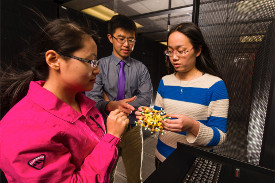Atomistic Modeling for Catalyst Development and Novel Material Discovery
 Understanding chemical processes at the nano or sub-nano scale (~10-9 m) is a critical step to arrive at the solutions to the most challenging problems that chemical engineers encounter. Atomistic modeling provides an avenue to explore and investigate complex chemical, physical processes; and extract the fundamental thermodynamic and kinetic information governing these processes. Based on quantum mechanical theory and advanced computing techniques, our group is interested in a variety of scientifically and industrially relevant chemical processes, which can be classified into two main areas in catalyst development; and novel material discovery. The specific projects are:
Understanding chemical processes at the nano or sub-nano scale (~10-9 m) is a critical step to arrive at the solutions to the most challenging problems that chemical engineers encounter. Atomistic modeling provides an avenue to explore and investigate complex chemical, physical processes; and extract the fundamental thermodynamic and kinetic information governing these processes. Based on quantum mechanical theory and advanced computing techniques, our group is interested in a variety of scientifically and industrially relevant chemical processes, which can be classified into two main areas in catalyst development; and novel material discovery. The specific projects are:
- First-principles-based kinetic modeling for catalyst optimization and design: Water-gas shift reaction (WGSR) is a major catalytic process for fuels and chemicals production. Efficient WGSR catalysts play a significant role in improving hydrogen production and selectivity. While WSGR is often coupled with other reactions, such as C-C bond or C-O bond cleavage, it requires that the catalyst be sufficiently active and selective. We focus on the economical Ni-based catalysts and aims to improve its WGSR selectivity, particularly against side reactions such as methanation. Density functional theory (DFT) calculations are performed on the elementary reaction steps by considering all common Ni single crystal facets to obtain the reaction energetics and kinetics. Ultimately, such information is used to construct a microkinetic model to assess the performances of known catalysts and also to predict the properties of new WGSR catalyst materials.
- Mechanistic investigation of selective methane oxidation: Methane is an extremely abundant and cheap chemical feedstock. Our aim is to understand the mechanism of methane oxidation and conversion into other chemicals so as to develop novel catalytic processes for better and more energy efficient hydrocarbon utilizations. Current project focuses on methane oxidation on iron oxide, which is an important oxygen carrier for Chemical Looping Combustion (CLC) and used as a model catalyst in this study. Using density functional theory with Hubbard U corrections, this work also aims to extend to the direct conversion of methane into other high-value oxygenated hydrocarbons.
- Computational biomass processing via electrocatalysis: Electrochemical treatment of biomass compounds, via electroreduction or electrooxidation, is an appealing technology, which can be integrated with other renewable energy platforms, such as wind, solar. First-principles method, coupled with experimental electrochemical groups, is applied to design effective and efficient metal-based electrode materials for furfural conversion into furfuryl alcohol, methylfuran. Computational methodology have been developed and applied to fully and accurately describe the relevant electrochemistry in aqueous environment on a wide array of potential electrode materials.
- Multiscale molecular modeling for 2-D material synthesis: Hexagonal boron nitride (hBN) is a fascinating material with graphene-like structure, but rather unique electrical properties as a promising dielectric material. The objective of our study is to develop a uniform theoretical framework combining DFT calculations and classic force field potential (ReaxFF) by focusing on the formation of hBN crystals under different synthesis routes (i.e. CVD and metal flux). This work is in close collaborations with Dr. Edgar’s synthesis group (K-State) and Dr. van Duin’s force field development team (Penn State). A long-term goal is to apply the developed model to provide guideline for experimental synthesis optimization and to realize eventual acceleration of novel material discovery.
Contact
Bin Liu
Associate Professor
785-532-4331
binliu@k-state.edu